Integrating BIM Forward Design with CFD Numerical Simulation for Wind Turbine Blade Analysis
Abstract
1. Introduction
2. Methodology
2.1. BIM+ Numerical Simulation Method
2.1.1. BIM+ Numerical Simulation Analysis Framework
2.1.2. BIM and Numerical Simulation Data Transfer Method
2.2. Blade-Element Theory
2.3. CFD Numerical Simulation
2.3.1. Fluid Control Equations
2.3.2. Solid Control Equations
2.3.3. Fluid-Solid Coupling Boundary Conditions
3. Constructing BIM Model of Blades
3.1. Design Overview
3.1.1. Wind Turbine Design Parameters
3.1.2. Airfoil Design Parameters
3.2. Pre-Processing for Constructing BIM Models
3.2.1. Parameter Setting
3.2.2. Obtaining 2D Coordinates of Cross-Section
3.2.3. Solving for 3D Coordinates
3.3. Generating Blade Cross-Section Curves
3.4. Generating the Entity Model of Blade
3.4.1. Generating Preliminary Model
3.4.2. Checking and Trimming of Blade Model Surfaces
4. Numerical Simulation and Results Analysis of Blades
4.1. Setting Parameters and Meshing
4.1.1. Working Condition Parameters
4.1.2. CFD Modeling
4.1.3. Finite Element Modeling of Blades
4.2. Mesh Independence Verification
4.3. Numerical Results Analysis
4.3.1. Wind Pressure Analysis
4.3.2. Blade Structure Displacement Analysis
5. Verification and Application of the Numerical Results
5.1. Comparative Validation of the Numerical Results
5.1.1. Verification of Wind Pressure Analysis Results
5.1.2. Verification of Displacement Analysis Results
5.2. Coupling of Numerical Simulation Results with BIM Model
6. Conclusions
Author Contributions
Funding
Data Availability Statement
Conflicts of Interest
Appendix A
| Rotor Radius r/(m) | Chord Length c/(m) | Thickness t/(m) | t/c/(%) | Torsion Angle β/(°) |
|---|---|---|---|---|
| 3.46 | 3.60 | 1.567 | 43.54 | 9.0 |
| 4.96 | 3.45 | 1.251 | 36.25 | 8.5 |
| 6.46 | 3.30 | 1.009 | 30.58 | 8.0 |
| 7.96 | 3.15 | 0.836 | 26.53 | 7.5 |
| 9.46 | 3.00 | 0.723 | 24.10 | 7.0 |
| 10.96 | 2.85 | 0.643 | 22.55 | 6.5 |
| 12.46 | 2.70 | 0.571 | 21.13 | 6.0 |
| 13.96 | 2.55 | 0.506 | 19.85 | 5.5 |
| 15.46 | 2.40 | 0.449 | 18.70 | 5.0 |
| 16.96 | 2.25 | 0.398 | 17.69 | 4.5 |
| 18.46 | 2.10 | 0.353 | 16.81 | 4.0 |
| 19.96 | 1.95 | 0.313 | 16.07 | 3.5 |
| 21.46 | 1.80 | 0.278 | 15.46 | 3.0 |
| 22.96 | 1.65 | 0.246 | 14.92 | 2.5 |
| 24.46 | 1.50 | 0.216 | 14.38 | 2.0 |
| 25.96 | 1.35 | 0.187 | 13.84 | 1.5 |
| 27.46 | 1.20 | 0.160 | 13.30 | 1.0 |
| 28.96 | 1.05 | 0.134 | 12.76 | 0.5 |
| 30.46 | 0.90 | 0.110 | 12.22 | 0.0 |
References
- Hannan, M.A.; Al-Shetwi, A.Q.; Mollik, M.S.; Ker, P.J.; Mannan, M.; Mansor, M.; Al-Masri, H.M.K.; Mahlia, T.M.I. Wind energy conversions, controls, and applications: A review for sustainable technologies and directions. Sustainability 2023, 15, 3986. [Google Scholar] [CrossRef]
- Badger, J.; Volker, P.J.H. Efficient large-scale wind turbine deployment can meet global electricity generation needs. Proc. Natl. Acad. Sci. USA 2017, 114, E8945. [Google Scholar] [CrossRef] [PubMed]
- Verma, A.S.; Yan, J.; Hu, W.; Jiang, Z.; Shi, W.; Teuwen, J.J. A review of impact loads on composite wind turbine blades: Impact threats and classification. Renew. Sustain. Energy Rev. 2023, 178, 113261. [Google Scholar] [CrossRef]
- Dai, J.; Li, M.; Chen, H.; He, T.; Zhang, F. Progress and challenges on blade load research of large-scale wind turbines. Renew. Energy 2022, 196, 482–496. [Google Scholar] [CrossRef]
- Schubel, P.J.; Crossley, R.J. Wind turbine blade design. Energies 2012, 5, 3425–3449. [Google Scholar] [CrossRef]
- Djerrad, A.; Fan, F.; Zhi, X.; Wu, Q. Experimental and FEM analysis of AFRP strengthened short and long steel tube under axial compression. Thin-Walled Struct. 2019, 139, 9–23. [Google Scholar] [CrossRef]
- Zou, Y.; Zhao, X.; Chen, Q. Comparison of STAR-CCM+ and ANSYS Fluent for simulating indoor airflows. Build. Simul. 2018, 11, 165–174. [Google Scholar] [CrossRef]
- Zheng, X.; Zhou, Y. A three-dimensional unsteady numerical model on a novel aerogel-based PV/T-PCM system with dynamic heat-transfer mechanism and solar energy harvesting analysis. Appl. Energy 2023, 338, 120899. [Google Scholar] [CrossRef]
- Dou, J.-H.; Jia, X.; Huang, Z.-X.; Gu, X.-H.; Zheng, Y.-M.; Ma, B.; Xiao, Q.-Q. Theoretical and numerical simulation study on jet formation and penetration of different liner structures driven by electromagnetic pressure. Def. Technol. 2021, 17, 846–858. [Google Scholar] [CrossRef]
- Rhakasywi, D.; Harinaldi; Kosasih, E.A.; Irwansyah, R. Computational and Experimental Study of Heat Transfer on the heat sink with an impinging synthetic jet under Various Excitation Wave. Case Stud. Therm. Eng. 2021, 26, 101106. [Google Scholar] [CrossRef]
- de Schiara, L.S.; de Ribeiro, G.O. Finite element mesh generation for fracture mechanics in 3D coupled with ansys®: Elliptical cracks and lack of fusion in nozzle welds. J. Braz. Soc. Mech. Sci. Eng. 2016, 38, 253–263. [Google Scholar] [CrossRef]
- Yang, B.; Liu, B.; Zhu, D.; Zhang, B.; Wang, Z.; Lei, K. Semiautomatic Structural BIM-Model Generation Methodology Using CAD Construction Drawings. J. Comput. Civ. Eng. 2020, 34, 04020006. [Google Scholar] [CrossRef]
- Cheng, M.-Y.; Soegiono, D.V.; Khitam, A.F. Automated fall risk classification for construction workers using wearable devices, BIM, and optimized hybrid deep learning. Autom. Constr. 2025, 172, 106072. [Google Scholar] [CrossRef]
- Wang, L.; Lee, J.; Nimawat, J.; Han, K.; Gupta, A. Integrated 4D Design Change Management Model for Construction Projects. J. Constr. Eng. Manag. 2024, 150, 04024023. [Google Scholar] [CrossRef]
- Wang, H.; Jin, R.; Xu, P.; Gu, J. Generation Method for HVAC Systems Design Schemes in Office Buildings Based on Deep Graph Generative Models. Buildings 2024, 14, 3405. [Google Scholar] [CrossRef]
- Aghaabbasi, M.; Sabri, S. Potentials of digital twin system for analyzing travel behavior decisions. Travel Behav. Soc. 2025, 38, 100902. [Google Scholar] [CrossRef]
- Tuhaise, V.V.; Tah, J.H.M.; Abanda, F.H. Technologies for digital twin applications in construction. Autom. Constr. 2023, 152, 104931. [Google Scholar] [CrossRef]
- Zhang, Z.; Wei, Z.; Court, S.; Yang, L.; Wang, S.; Thirunavukarasu, A.; Zhao, Y. A Review of Digital Twin Technologies for Enhanced Sustainability in the Construction Industry. Buildings 2024, 14, 1113. [Google Scholar] [CrossRef]
- Tahmasebinia, F.; Lin, L.; Wu, S.; Kang, Y.; Sepesgozar, S. Advanced Energy Performance Modelling: Case Study of an Engineering and Technology Precinct. Buildings 2024, 14, 1774. [Google Scholar] [CrossRef]
- Lee, Y.-C.; Eastman, C.M.; Solihin, W. Rules and validation processes for interoperable BIM data exchange. J. Comput. Des. Eng. 2021, 8, 97–114. [Google Scholar] [CrossRef]
- Xu, P.; Liu, P.; Yan, L.; Zhang, Z. Effect of Solder Layer Void Damage on the Temperature of IGBT Modules. Micromachines 2023, 14, 1344. [Google Scholar] [CrossRef] [PubMed]
- Kang, M.; Bian, J.; Li, B.; Fan, X.; Xi, Y.; Wang, Y.; Liu, Y.; Zhu, Y.; Zi, W. Advanced progress of numerical simulation in drum drying process: Gas–solid flow model and simulation of flow characteristics. Int. Commun. Heat Mass Transf. 2024, 157, 107758. [Google Scholar] [CrossRef]
- Sayed, M.; Lutz, T.; Krämer, E.; Shayegan, S.; Wüchner, R. Aeroelastic analysis of 10 MW wind turbine using CFD–CSD explicit FSI-coupling approach. J. Fluids Struct. 2019, 87, 354–377. [Google Scholar] [CrossRef]
- Liu, X.; Lu, C.; Liang, S.; Godbole, A.; Chen, Y. Vibration-induced aerodynamic loads on large horizontal axis wind turbine blades. Appl. Energy 2017, 185, 1109–1119. [Google Scholar] [CrossRef]
- Sayed, M.A.; Kandil, H.A.; Shaltot, A. Aerodynamic analysis of different wind-turbine-blade profiles using finite-volume method. Energy Convers. Manag. 2012, 64, 541–550. [Google Scholar] [CrossRef]
- Tadamasa, A.; Zangeneh, M. Numerical prediction of wind turbine noise. Renew. Energy 2011, 36, 1902–1912. [Google Scholar] [CrossRef]
- Ismaiel, A. A Multivariate Machine Learning Approach for the Prediction of Wind Turbine Blade Structural Dynamics. Appl. Syst. Innov. 2025, 8, 12. [Google Scholar] [CrossRef]
- Pourtousi, M.; Sahu, J.; Ganesan, P.; Shamshirband, S.; Redzwan, G. A combination of computational fluid dynamics (CFD) and adaptive neuro-fuzzy system (ANFIS) for prediction of the bubble column hydrodynamics. Powder Technol. 2015, 274, 466–481. [Google Scholar] [CrossRef]
- Zhang, Y.; Zhang, J.; Wang, C.; Ren, X. An integrated framework for improving the efficiency and safety of hydraulic tunnel construction. Tunn. Undergr. Space Technol. 2023, 131, 104836. [Google Scholar] [CrossRef]
- Tusnina, O.; Alekseytsev, A. LOD of a Computational Numerical Model for Evaluating the Mechanical Safety of Steel Structures. Buildings 2023, 13, 1941. [Google Scholar] [CrossRef]
- Zheng, L.; Lu, W.; Wu, L.; Zhou, Q. A review of integration between BIM and CFD for building outdoor environment simulation. Build. Environ. 2023, 228, 109862. [Google Scholar] [CrossRef]
- Jiang, S.; Feng, X.; Zhang, B.; Shi, J. Semantic enrichment for BIM: Enabling technologies and applications. Adv. Eng. Informatics 2023, 56, 101961. [Google Scholar] [CrossRef]
- Sun, S.; Liu, X.; Zhang, R.; Liu, C.; Wang, A. Numerical Simulation and Analysis of Hydraulic Turbines Based on BIM for Sustainable Development. Sustainability 2023, 15, 16168. [Google Scholar] [CrossRef]
- Ramaji, I.J.; Messner, J.I.; Mostavi, E. IFC-Based BIM-to-BEM Model Transformation. J. Comput. Civ. Eng. 2020, 34, 04020005. [Google Scholar] [CrossRef]
- Fudlailah, P.; Allen, D.H.; Cordes, R. Verification of Euler–Bernoulli beam theory model for wind blade structure analysis. Thin-Walled Struct. 2024, 202, 111989. [Google Scholar] [CrossRef]
- Manwell, J.F.; McGowan, J.G.; Rogers, A.L. Wind Energy Explained: Theory, Design and Application; John Wiley & Sons: Hoboken, NJ, USA, 2010. [Google Scholar]
- Jia, R.; Xia, H.; Zhang, S.; Su, W.; Xu, S. Optimal design of Savonius wind turbine blade based on support vector regression surrogate model and modified flower pollination algorithm. Energy Convers. Manag. 2022, 270, 116247. [Google Scholar] [CrossRef]
- Shu, W. On a new 3D model for incompressible euler and navier-stokes equations. Acta Math. Sci. 2010, 30, 2089–2102. [Google Scholar] [CrossRef]
- Firoozi, A.A.; Hejazi, F.; Firoozi, A.A. Advancing Wind Energy Efficiency: A Systematic Review of Aerodynamic Optimization in Wind Turbine Blade Design. Energies 2024, 17, 2919. [Google Scholar] [CrossRef]
- Bae, S.-Y.; Kim, Y.-H. Structural design and analysis of large wind turbine blade. Mod. Phys. Lett. B 2019, 33, 1940032. [Google Scholar] [CrossRef]
- Chen, X.; Agarwal, R.K. Optimization of Wind Turbine Blade Airfoils Using a Multi-Objective Genetic Algorithm. J. Aircr. 2013, 50, 519–527. [Google Scholar] [CrossRef]
- Guie, T.; Jiudong, Y.; Jinhua, W. Analysis of MATLAB for Data Processing in Surveying and Mapping. Agro Food Ind. Hi-Tech 2017, 28, 280–284. [Google Scholar]
- Rossgatterer, M.; Jüttler, B.; Kapl, M.; Della Vecchia, G. Medial design of blades for hydroelectric turbines and ship propellers. Comput. Graph. 2012, 36, 434–444. [Google Scholar] [CrossRef]
- Sorgente, T.; Biasotti, S.; Manzini, G.; Spagnuolo, M. A survey of Indicators for Mesh Quality Assessment. In Computer Graphics Forum; Wiley: Hoboken, NJ, USA, 2023; Volume 42, pp. 461–483. [Google Scholar]
- Meana-Fernández, A.; Oro, J.M.F.; Díaz, K.M.A.; Galdo-Vega, M.; Velarde-Suárez, S. Application of Richardson extrapolation method to the CFD simulation of vertical-axis wind turbines and analysis of the flow field. Eng. Appl. Comput. Fluid Mech. 2019, 13, 359–376. [Google Scholar] [CrossRef]
- Kim, B.; Park, S.-J.; Ahn, S.; Kim, M.-G.; Yang, H.-G.; Ji, H.-S. Numerically and Experimentally Verified Design of a Small Wind Turbine with Injection Molded Blade. Processes 2021, 9, 776. [Google Scholar] [CrossRef]
- Li, Z.; Yang, X. Resolvent-based motion-to-wake modelling of wind turbine wakes under dynamic rotor motion. J. Fluid Mech. 2024, 980, A48. [Google Scholar] [CrossRef]
- Lee, H.M.; Wu, Y.-H. Experimental Study of Rotational Effect on Stalling. Chin. Phys. Lett. 2013, 30, 064703. [Google Scholar] [CrossRef]
- Bin Shahadat, M.R.; Doranehgard, M.H.; Cai, W.; Meneveau, C.; Schafer, B.; Li, Z. An airfoil-based synthetic actuator disk model for wind turbine aerodynamic and structural analysis. Renew. Energy 2025, 255, 123780. [Google Scholar] [CrossRef]
- Bai, D.; Wang, B.; Li, Y.; Wang, W. Study on load reduction and vibration control strategies for semi-submersible offshore wind turbines. Sci. Rep. 2025, 15, 1148. [Google Scholar] [CrossRef] [PubMed]
- Elias, S. Vibration Improvement of Offshore Wind Turbines Under Multiple Hazards. In Structures; Elsevier: Hoboken, NJ, USA, 2024; Volume 59, p. 105800. [Google Scholar]
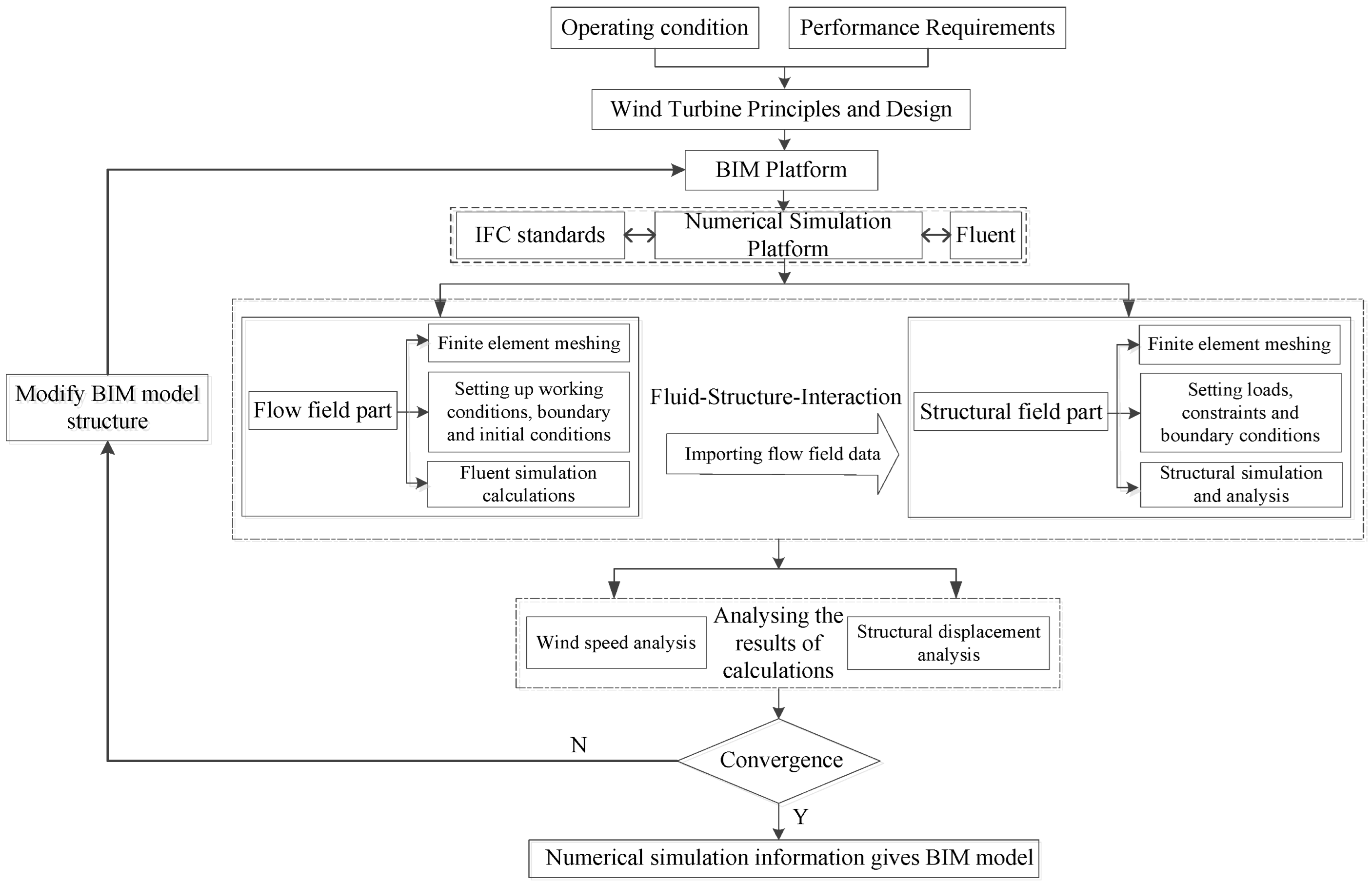
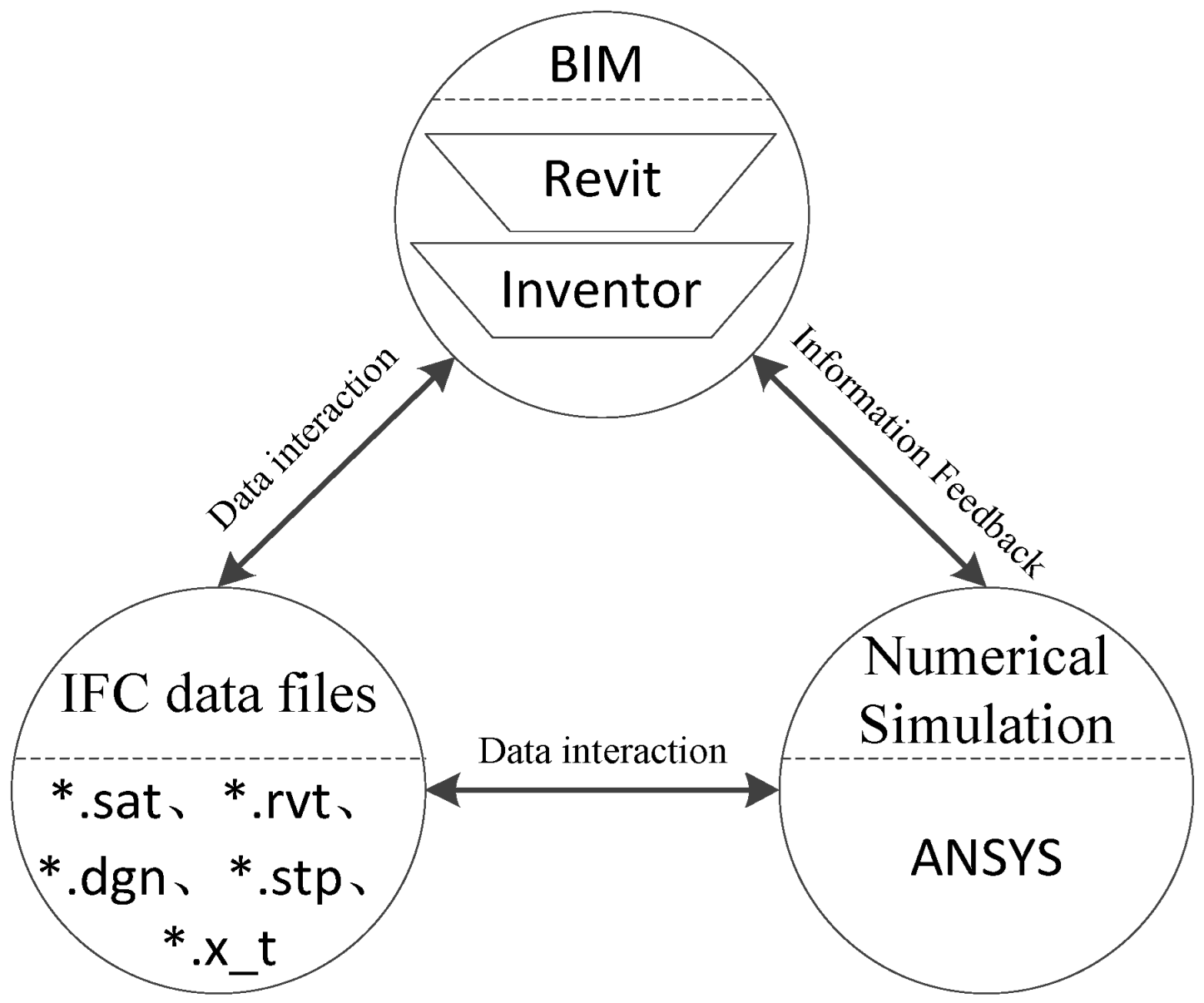
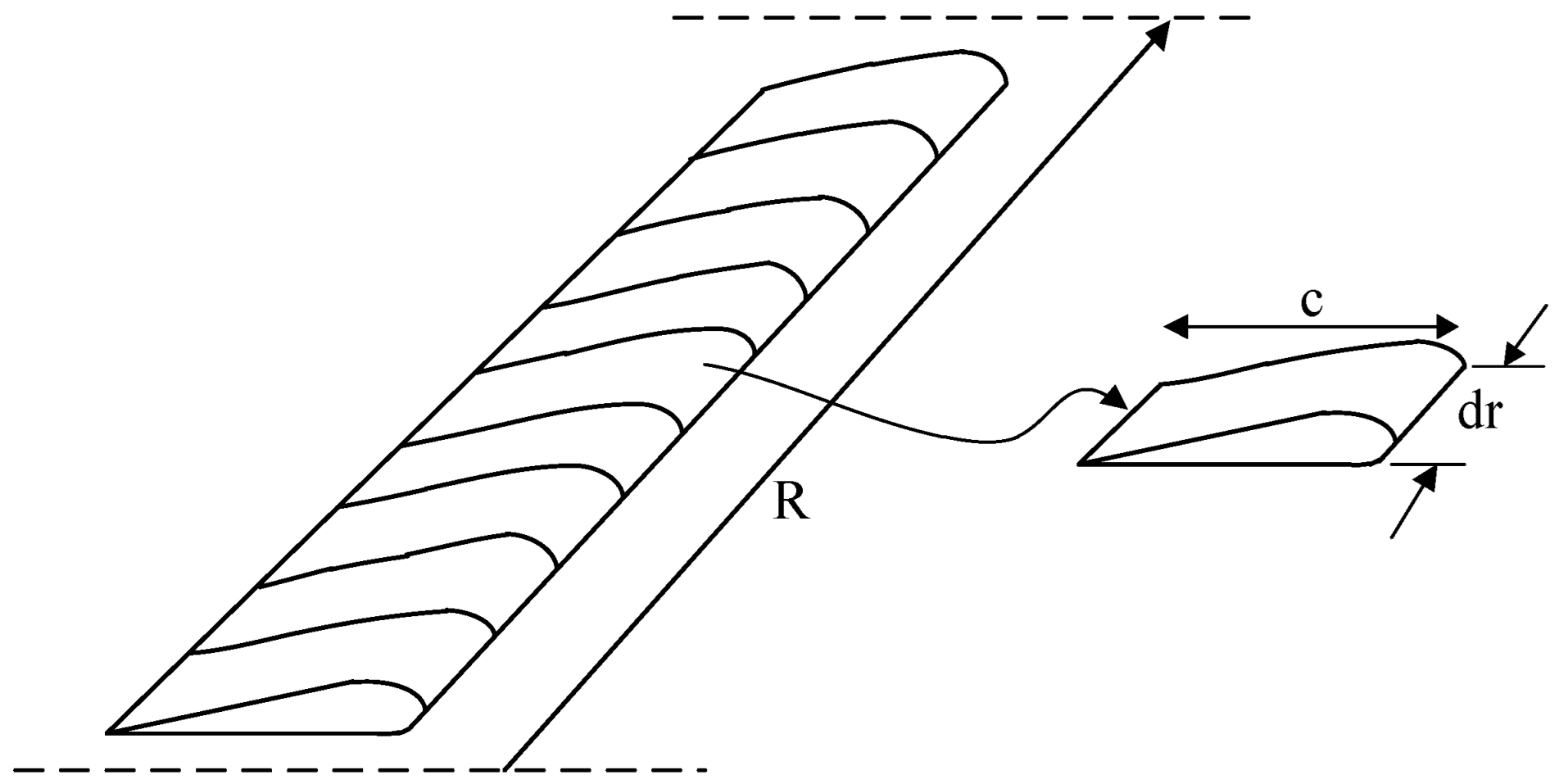

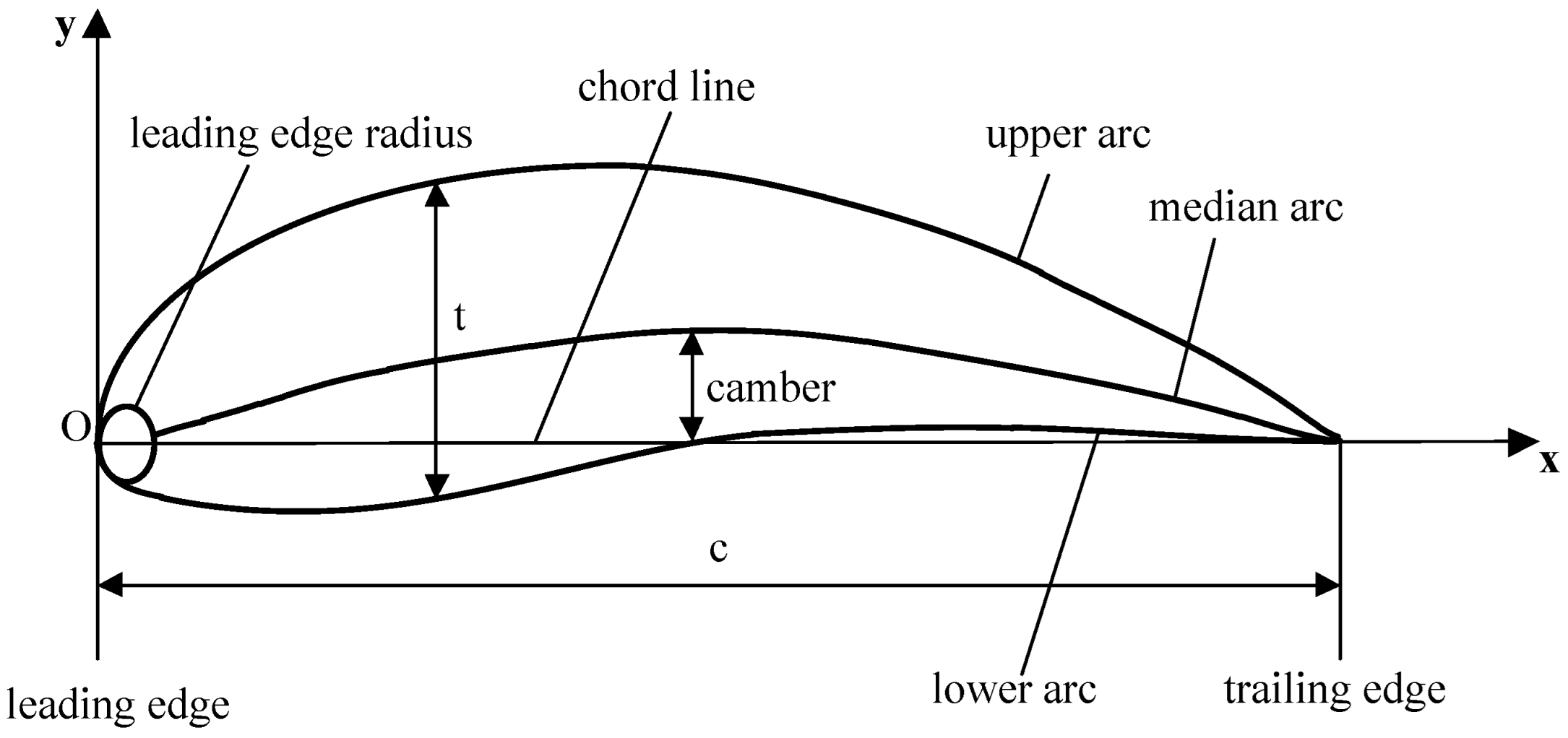
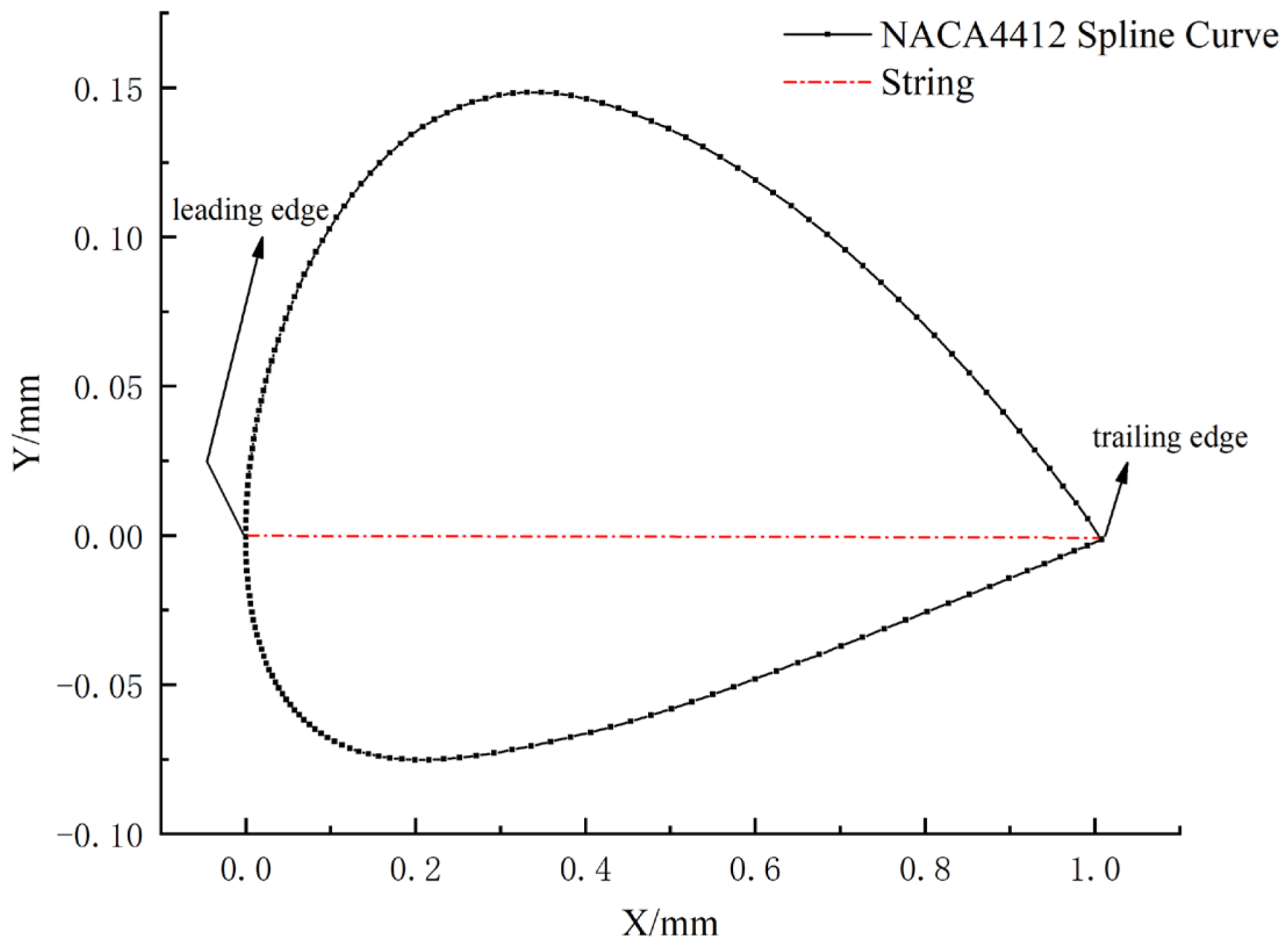
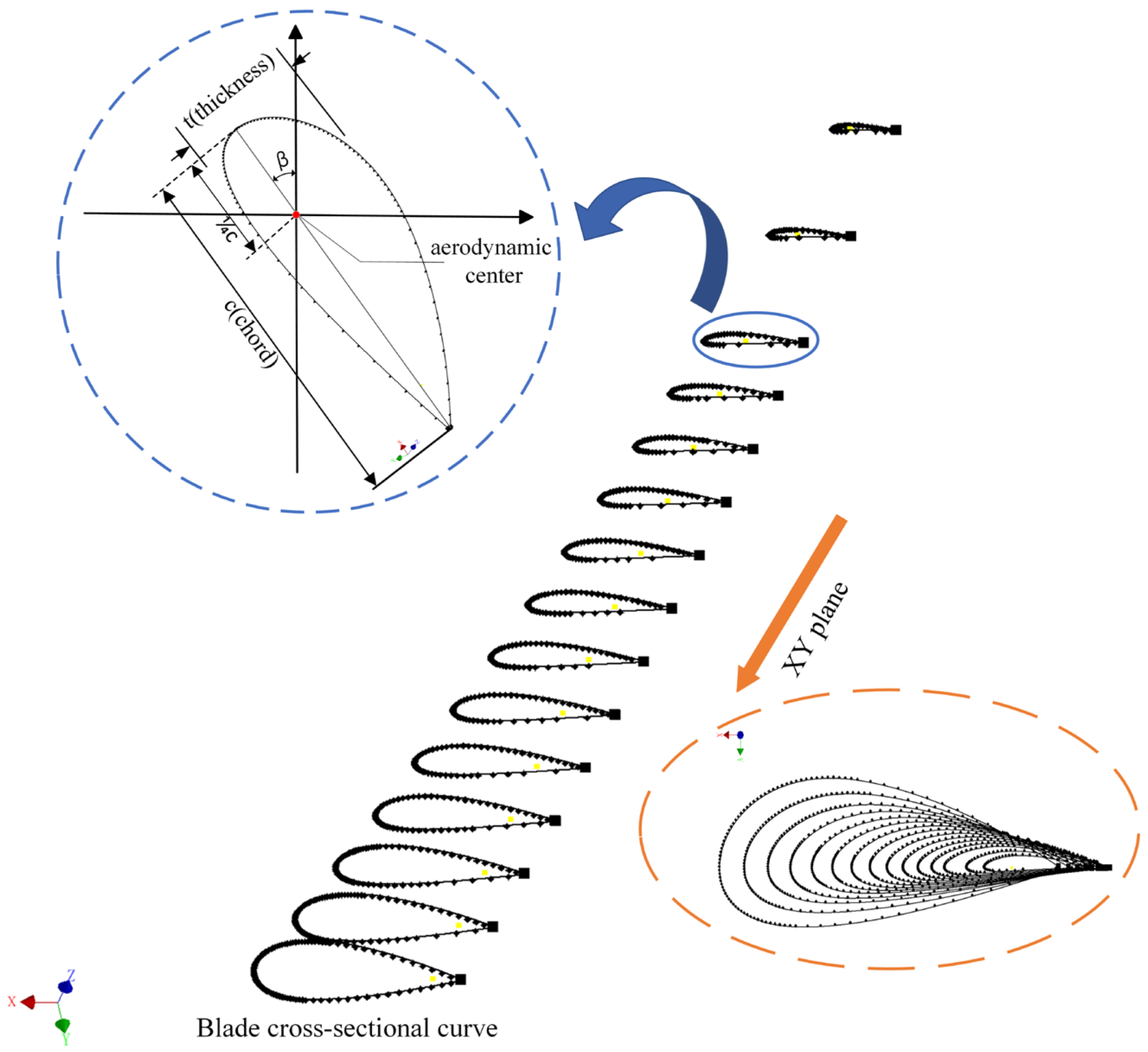
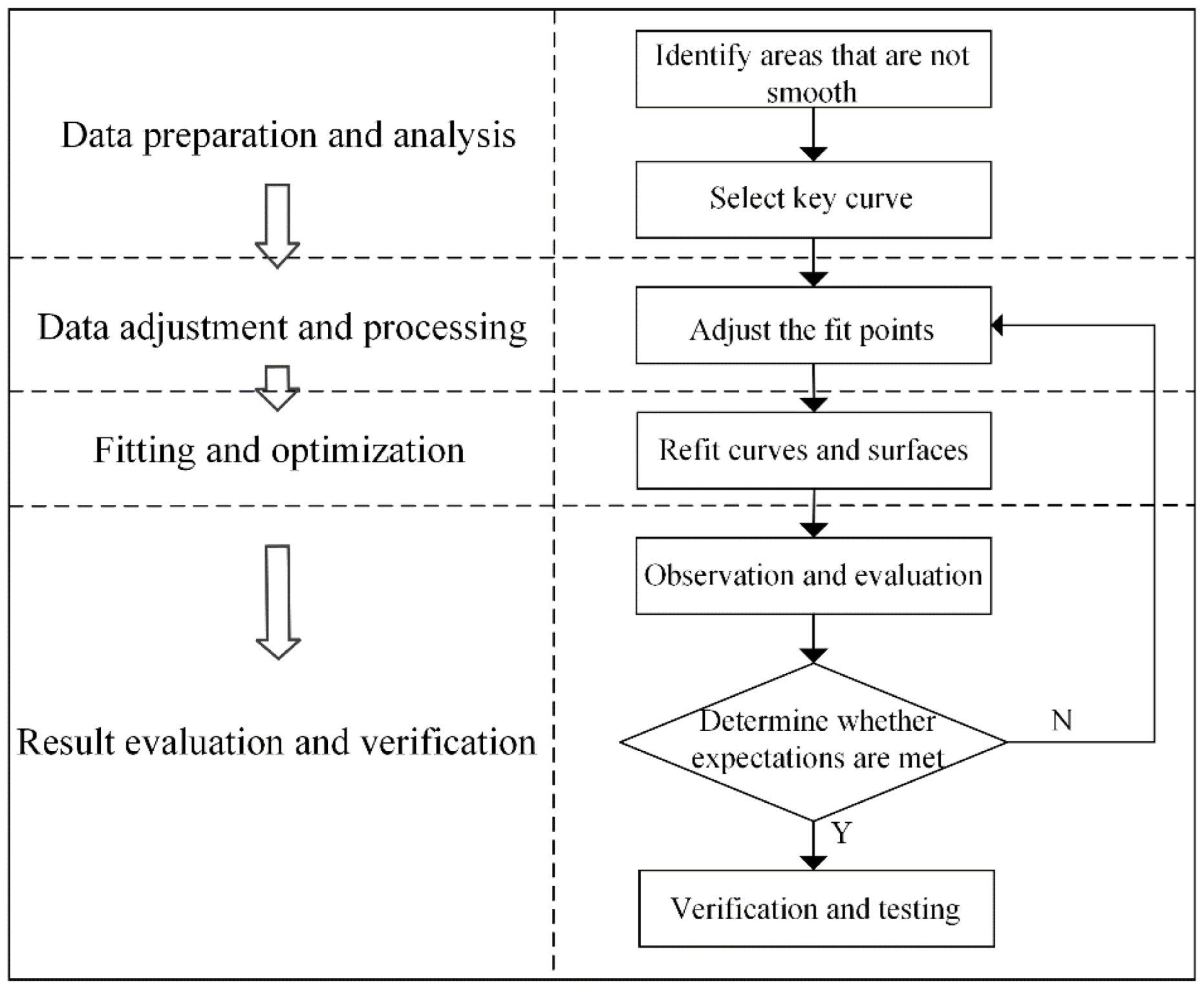

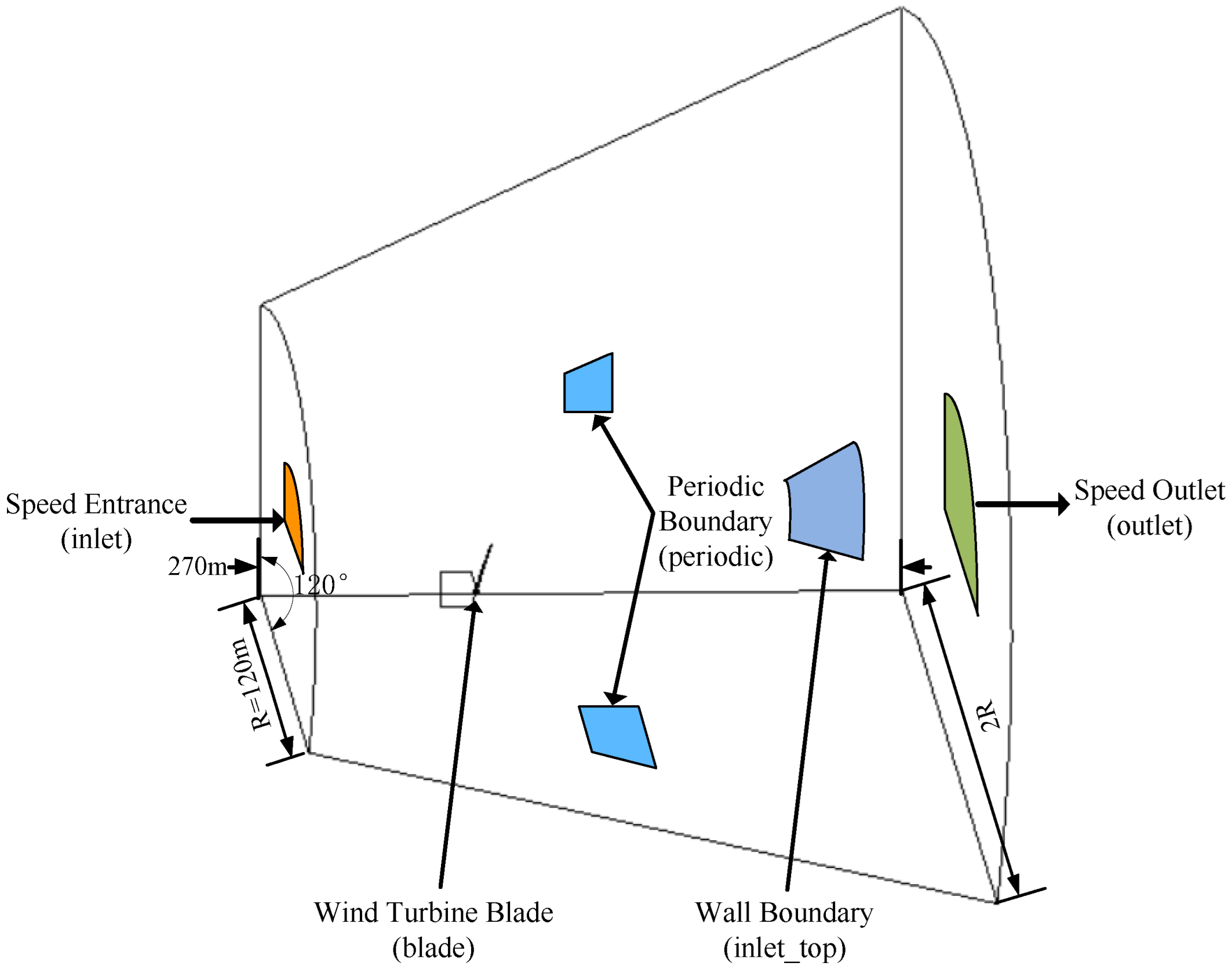
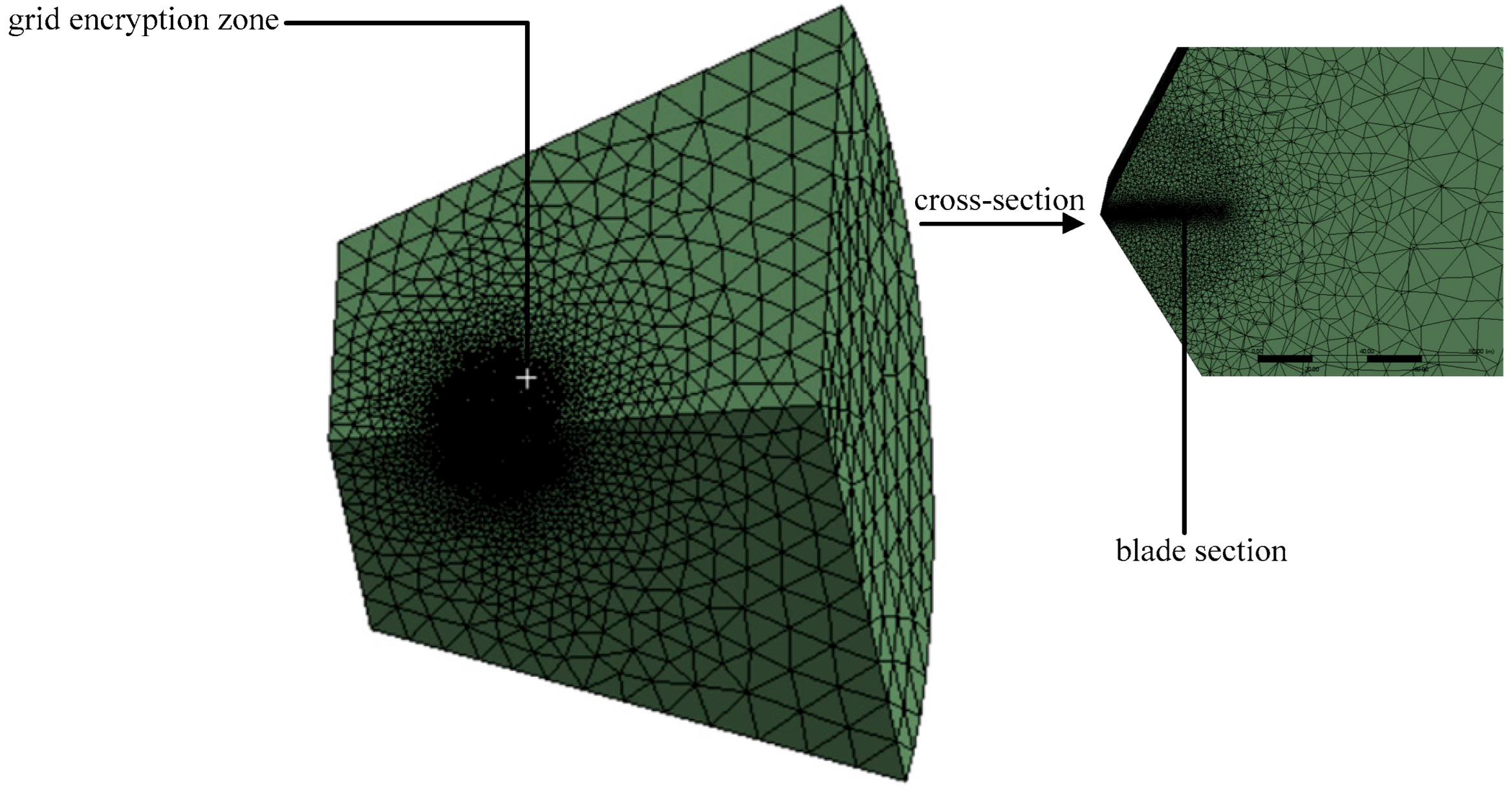


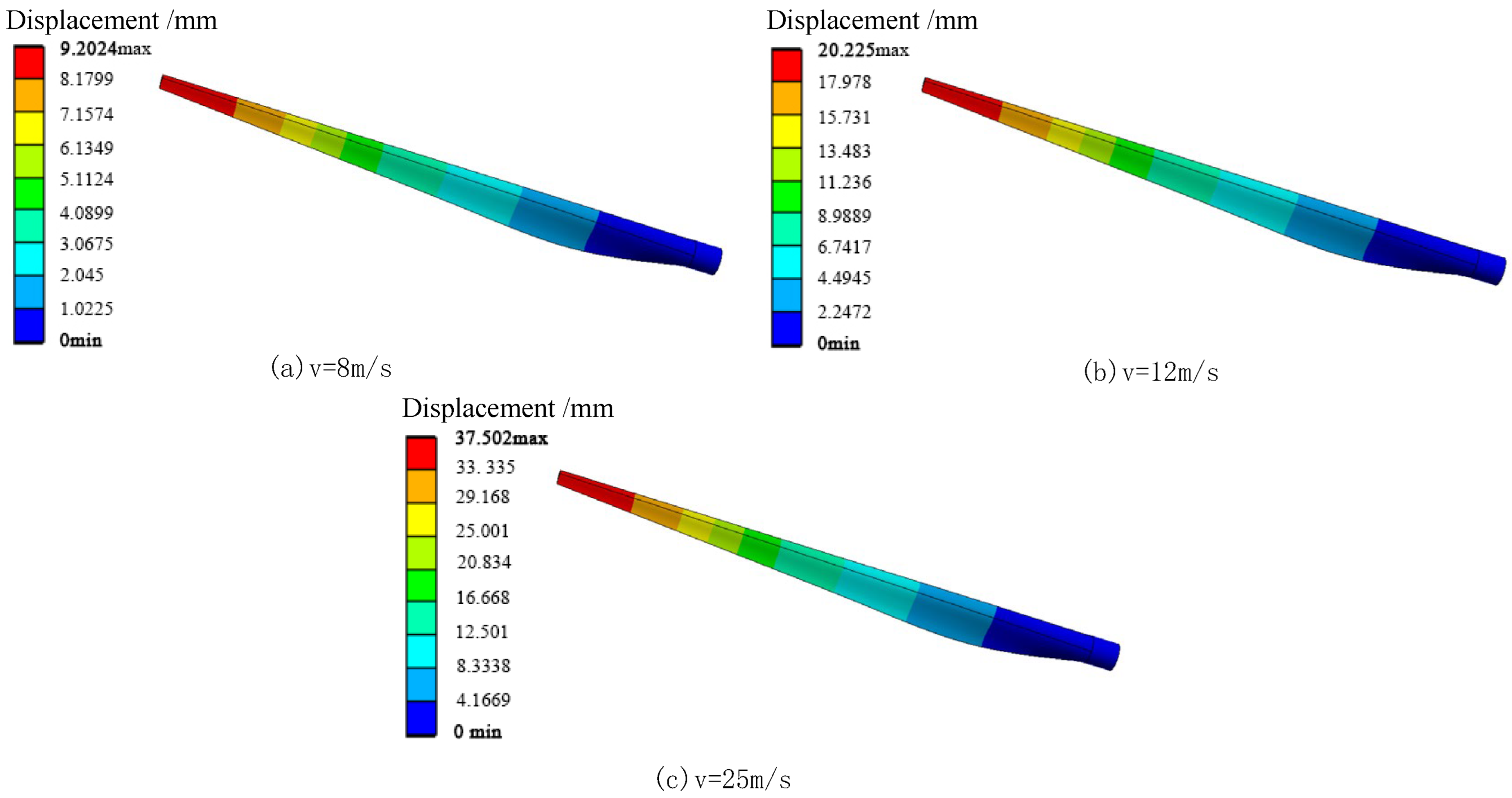
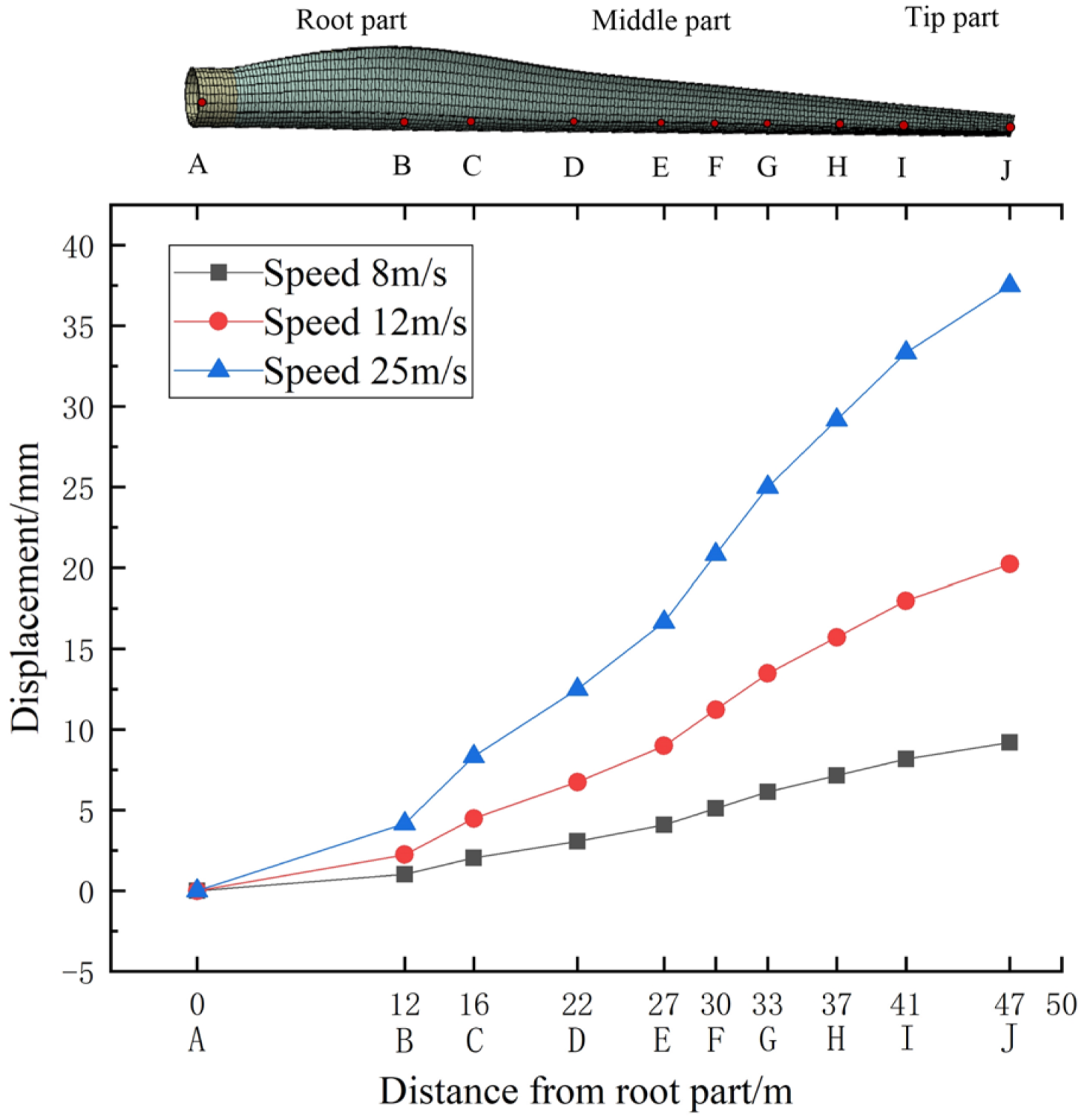
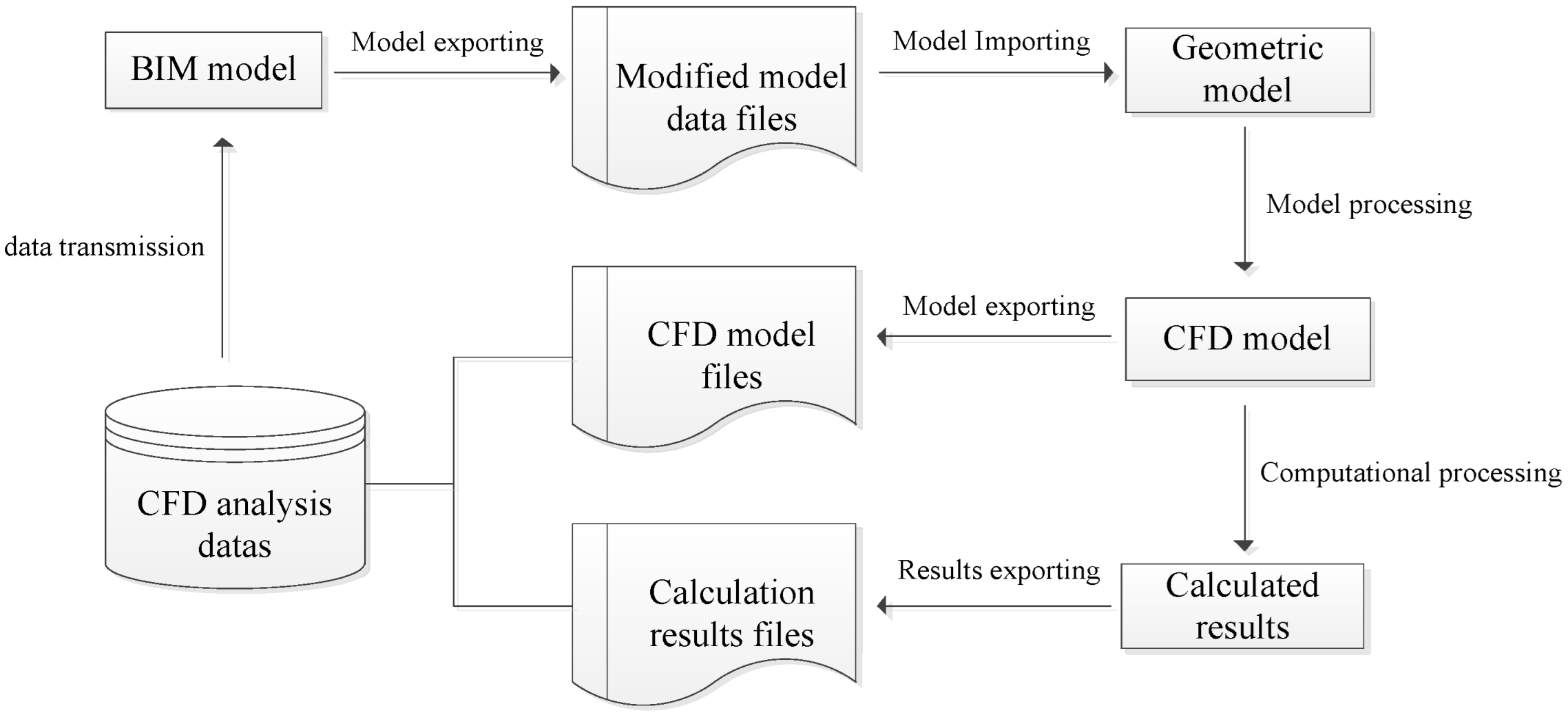
| Parameters | Numerical Value |
|---|---|
| Rated power/MW | 2.2 |
| Rated wind speed/m/s | 12 |
| Cut-in wind speed/m/s | 3 |
| Cut-out wind speed/m/s | 25 |
| Number of blades | 3 |
| Rotor diameter, Hub diameter/m | 98.5, 4 |
| Length of blade/m | 47.3 |
| Tower height/m | 65 |
| Simulated Working Conditions | Inlet Wind Speed/m/s | Outlet Pressure/Pa |
|---|---|---|
| Low wind speed | 8 | 101,325 |
| Rated wind speed | 12 | 101,325 |
| High wind speed | 25 | 101,325 |
| Mesh Level | Number of Nodes | Computational Time (h) | Mesh Quality (Min. Orthogonality) | ||
|---|---|---|---|---|---|
| Coarse | 34,870 | 0.458 | 0.083 | 1.8 | 0.35 |
| Medium | 69,960 | 0.478 | 0.089 | 4.5 | 0.42 |
| Fine | 142,530 | 0.483 | 0.091 | 20.1 | 0.48 |
| Benchmark | - | 0.486 | 0.092 | - | - |
| Mesh Comparison | (%) | (%) | Convergence |
|---|---|---|---|
| Coarse → Medium | +7.23 | +4.37 | Not converged |
| Medium → Fine | +2.25 | +1.05 | Converged |
| Fine → Benchmark | +1.10 | +0.62 | Fully converged |
Disclaimer/Publisher’s Note: The statements, opinions and data contained in all publications are solely those of the individual author(s) and contributor(s) and not of MDPI and/or the editor(s). MDPI and/or the editor(s) disclaim responsibility for any injury to people or property resulting from any ideas, methods, instructions or products referred to in the content. |
© 2025 by the authors. Licensee MDPI, Basel, Switzerland. This article is an open access article distributed under the terms and conditions of the Creative Commons Attribution (CC BY) license (https://creativecommons.org/licenses/by/4.0/).
Share and Cite
Sun, S.; Li, M.; Shi, Y.; Liu, C.; Wang, A. Integrating BIM Forward Design with CFD Numerical Simulation for Wind Turbine Blade Analysis. Energies 2025, 18, 3989. https://doi.org/10.3390/en18153989
Sun S, Li M, Shi Y, Liu C, Wang A. Integrating BIM Forward Design with CFD Numerical Simulation for Wind Turbine Blade Analysis. Energies. 2025; 18(15):3989. https://doi.org/10.3390/en18153989
Chicago/Turabian StyleSun, Shaonan, Mengna Li, Yifan Shi, Chunlu Liu, and Ailing Wang. 2025. "Integrating BIM Forward Design with CFD Numerical Simulation for Wind Turbine Blade Analysis" Energies 18, no. 15: 3989. https://doi.org/10.3390/en18153989
APA StyleSun, S., Li, M., Shi, Y., Liu, C., & Wang, A. (2025). Integrating BIM Forward Design with CFD Numerical Simulation for Wind Turbine Blade Analysis. Energies, 18(15), 3989. https://doi.org/10.3390/en18153989







